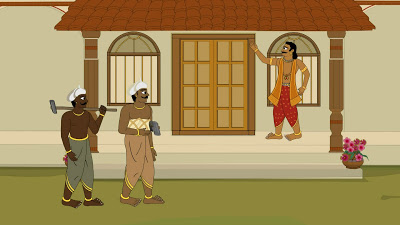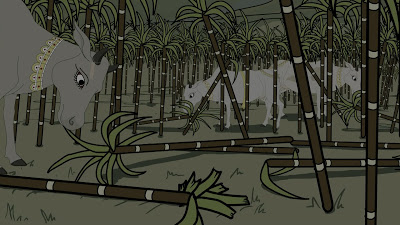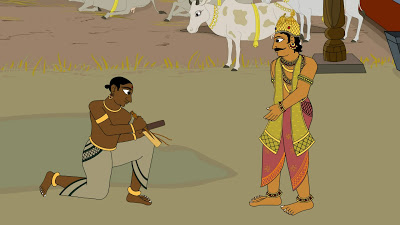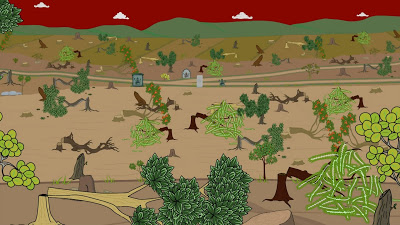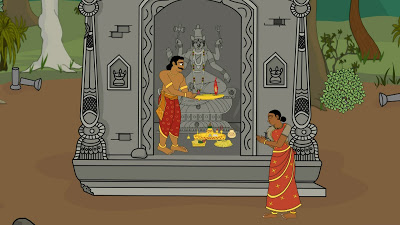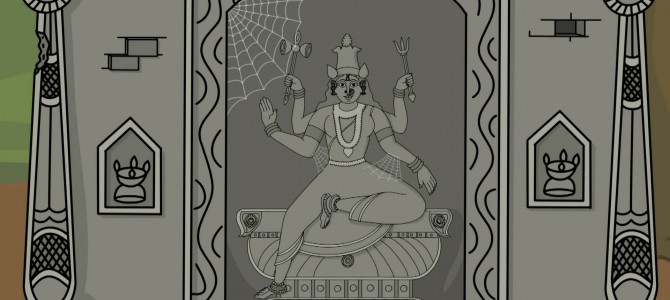WHO DOES THIS BEAUTIFUL CHILD BELONG TO AND WHERE HAS IT BEEN HIDDEN?
This final blog of the first series (which has discussed episode one of the larger story only) actually draws on material more appropriately discussed in episode two. But because it has been added, in the video animation, as a “teaser” to what lies ahead, it deserves some commentary here as well. In this clip we
- Published in Blog
WHY IS THIS CRADLE EMPTY?
In the last clip, and its associated blog, we saw seven poor cows die cruelly on a staked fence. Although my comments interpret this as a sacrificial event, the cows themselves are innocent of this larger picture. Yes, they jump deliberately, but with the hope that they will sail over that fence rather than land
- Published in Blog
WHY IS THIS COW CALLING OUT IN DISTRESS?
As this Legend of Ponnivala clip opens we see the group of “sacred” and wandering cows, all hungry, emerging from the forest again on a second night. They remember that lush sugarcane field where they dined in secret yesterday and are planning to repeat the same adventure once again. But as they approach the field
- Published in Blog
WHY ARE PEARLS BEING USED TO PAY THE ARTISANS?
This new clip is quite straight forward but has been included as a possible teaching point for younger students. The scene starts with several good views of the fence being built followed by a wider vista of the artisans’ finished work. Clearly this fence is a vicious obstacle. It has been designed to severely harm
- Published in Blog
WHAT HAS HAPPENED TO THE SOCIAL STATUS OF THE ARTISANS?
In the last clip (blog post 1.25) we saw the Chola’s cows eating their fill in Kolatta’s fine sugarcane field. They then leave, as a group. They are still able to move undetected in the darkness of the night. But then the sun rises and the farmer-hero-pioneer sets out to check on his ripening cane
- Published in Blog
SHOULD SACRED COWS BE ALLOWED TO RUIN THIS FINE SUGARCANE FIELD?
Now, immediately on the heels of the drought described in my previous blog(post 1.24), a second disaster unfolds in Ponnivala. The problem begins as the Chola’s ear-tagged cows reach Kolatta’s lands and find his finest field. It stands out for its tasty, near-mature crop of sugarcane. The cows eye the delicious-looking stand of tall stalks
- Published in Blog
WHY IS THIS SCRIBE WRITING NOTES IN THE KING’S COW SHED?
This clip presents a rather unique set of scenes. There has been a sudden and severe famine in the Chola’s kingdom. Interestingly enough, this repeats a very similar disaster event that earlier befell the Vellivala area, the place where Kolatta and his eight brothers first tried to farm (see blog post 1.7?). Everything is dry,
- Published in Blog
WHY HAVE ALL THESE TREES BEEN FELLED?
This short and simple video excerpt is included here as a set of add-on comments that build on my last blog (1.22) where one of the regularly repeated songs in the The Legend of Ponnivala epic is featured. That song speaks about the beauty of Ponnivala, its ripening fields of paddy and its lush, green
- Published in Blog
DOES THE LAND BENEFIT FROM THIS FARMER’S PRAYERS?
This clip begins with Kolatta remembering the Chola king’s words. He will indeed worship the local goddess of who cares for Ponnivala’s lands, Celatta, three times each day. We see the couple involved in this together. The two greet the goddess respectfully. Then Kolatta’s wife sweeps and clears the area in front of the temple.
- Published in Blog
WHY HAS THIS GODDESS SHRINE BEEN NEGLECTED?
The goddesses who guard the key local areas in this Legend of Ponnivala story are very important. We will encounter three key divine females in this epic, each having their own distinct shrine. These goddesses are Celatta, Kali (who is a kind of Durga-figure) and Karukali (or the black and very fearsome Kali). I will
- Published in Blog



